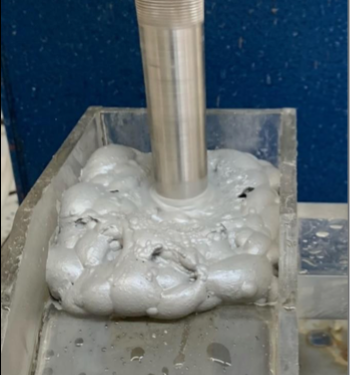Rumble Resources Limited (ASX: RTR) has reported “outstanding” initial flotation test work results from a sighter programme focused on the transition/fresh sulphide ores selected from the Chinook and Tonka Prospects at the Earaheedy Project in Western Australia.
“This is an exciting step forward for the project. The metallurgical test work carried out on the zinc sulphide dominant mineralisation has returned exceptional recoveries and grades via a simple and straightforward flotation process delivering a clean and highly marketable bulk concentrate. It compares favourably to current zinc producers and is positioned in the higher end of globally reported benchmarks,” Managing Director, Shane Sikora, said.
“Furthermore, these recoveries have been achieved at coarse grind sizes with an uncomplicated reagent scheme supporting a simple and conventional process flowsheet that will potentially result in much lower capital and operating costs to those typically observed in many zinc operations of this scale.”
“Work continues on the maiden JORC compliant Mineral Resource Estimate (MRE) for the Earaheedy Project for which we are now aiming to announce in the first half of 2023. This maiden MRE, in combination with the excellent metallurgy, open-pittable depths, provincial scale and being located in a Tier 1 mining jurisdiction will assist to establish the Earaheedy Project as a World Class zinc deposit and future producer of this critical future- facing commodity.”
Metallurgical Testwork Results
The metallurgical test work on the first sighter composites from the Earaheedy Project has been conducted at both IMO Metallurgical Laboratory Services, Perth (IMO) and Auralia Metallurgy, Perth on behalf of Rumble.
The work has been mainly focused on the flotation characteristics of the two deposits delineated by drilling at Chinook and Tonka over the past 18 months.
The metallurgical studies began on high grade representative samples from two sonic holes drilled approximately 500 metres apart – Composite A. At an early stage this work focused on the various flotation flowsheets which included differential zinc/ lead and bulk flotation. Initial quantitative mineralogical test work outcomes and the increasing zinc to lead ratios (> 4:1 Zn:Pb) reported in drilling during 2022, supported the decision to concentrate efforts on a bulk concentrate flotation scheme.
Metallurgical consulting firm Auralia was subsequently engaged to review the initial work performed at IMO and further optimise the bulk flotation flowsheet at coarser primary grind sizes using the Earaheedy site water. Testing at both laboratories provided confidence in the approach and outcomes from the work programme and assisted in developing the flowsheet for the subsequent Tonka Prospect composites.
Observations from the work performed to date has highlighted the fast-floating kinetics of the relatively coarse sphalerite at a coarse primary grind P80 of 150 microns, using standard reagents in site water. Rougher float times under three minutes were reported for the two Tonka (EHD019 and EHD027) composite samples, whilst excellent zinc recoveries (between 86% to 97%Zn) are observed in all three composite samples at the coarse grind size.
Additionally, it was noted that the rougher tailings are largely insensitive to this primary grind size, and thus there remains the opportunity to test at even coarser grind sizes. This coarse flotation and bulk concentrate can translate into numerous benefits for the Project, including;
• Reducing grinding power requirement and delivering significant energy savings per tonne
• Enhanced production rates via increased milling capacity
• Reduction in grinding media and liner costs
Subsequent regrinding of a low mass concentrate product to a P80 of circa 30-35 microns is required to improve the rejection of pyrite which further improves the grade of zinc and lead (59% Zn+Pb average) in the concentrate.
Whilst the company is at a very preliminary phase in its metallurgical studies, outstanding recoveries and marketable concentrate grades have been achieved, even at low grades eg Composite C reporting a 90% Zn recovery and 50% Zn grade in cleaner tests.
Going forward, optimisation of the flowsheet will look to continue reducing iron (pyrite) dilution in the concentrate to further improve the zinc grades.
For further information please visit: https://rumbleresources.com.au/












